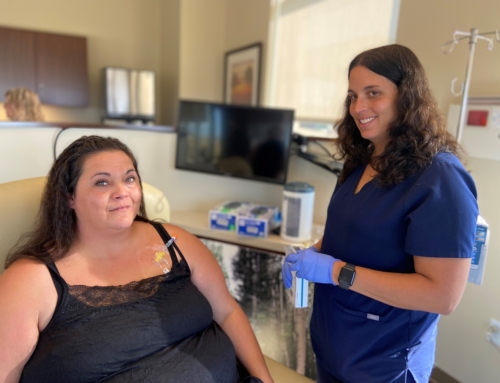By Lauren Glendenning, For Memorial Regional Health
Falls Prevention Awareness Day is Sept. 23
Our bones are developing and strengthening throughout our lives, with the most bone density occurring during our early 20s. As we age, our bones start thinning at varying degrees.
One in three adults over the age of 65 sustains a fall each year, said Jenna Kaspari, physical therapist at Memorial Regional Health. About 10 percent of these falls result in a serious injury, usually a fracture.
“Known as a silent disease because it progresses without symptoms, osteoporosis involves the gradual loss of bone tissue or bone density and results in bones so fragile they break under the slightest strain,” according to the National Institute of Arthritis and Musculoskeletal and Skin Diseases. “Consequently, falls are especially dangerous for people who are unaware that they have low bone density.”
Decreasing Risks
Falls are the leading cause of fatal and non-fatal injuries for older Americans, according to the National Council on Aging. Falling can threaten seniors’ safety and independence, and generates economic and personal costs.
“However, falling is not an inevitable result of aging,” according to the Council. “Through practical lifestyle adjustments, evidence-based falls prevention programs and clinical-community partnerships, the number of falls among seniors can be substantially reduced.”
Kaspari recommends focusing on the following areas in order to reduce your risk of falling:
1. Environmental
- Clean up clutter.
- Remove trip hazards.
- Install grab bars and handrails in the bathroom and on stairs.
- Use nonslip mats in the kitchen and bathroom.
- Use adequate lighting.
- Install raised toilet seats and shower chairs.
2. Balance and Gait
- Focus on walking and try not to multitask.
- If you feel off-balance, use an assistive device to reduce the risk of falling.
- If it’s snowy outside, give yourself extra travel time and take it slow.
- Practice balance in a safe environment.
- Set up a physical therapy evaluation to determine your fall risk and have a physical therapist provide you with a home program for improving your balance.
3. Personal Changes
- Have your vision checked and make sure your prescription is up to date.
- Wear supportive, nonslip shoes.
- Always have access to a phone or life alert button in case you fall and don’t have someone to assist you.
Reducing the Progression of Osteoporosis
The International Osteoporosis Foundation reports that one in three women and one in five men aged 50 or older are at risk of an osteoporotic fracture, most commonly occurring in the hip, spine or wrist.
Osteoporosis is associated with changes in balance and physical performance and has psychosocial consequences which increase the risk of falling, according to a study published in the Journal BMC Musculoskeletal Disorders.
Kaspari said to ask your provider about a Bone Mineral Density Test, and to ask about medications that can help slow bone deterioration and reduce fracture risk. Other practices that can help reduce the progression of osteoporosis include exercising several times per week, especially with weight-bearing exercises, and consuming adequate amounts of calcium and vitamin D.
Reduce Your Risk of Falling
If you’re an older American, you can lower your chances of falling by doing the following:
Talk openly with your healthcare provider about falls.
Tell a provider right away if you fall, worry about falling or feel unsteady. Have your doctor or pharmacist review all the medicines you take — even over-the-counter medicines.
Exercise to improve your balance and strength.
Exercises that improve balance and make your legs stronger lower your chances of falling. It also helps you feel better and more confident.
Have your eyes and feet checked.
Once a year, check with your eye doctor, and update your eyeglasses, if needed. Also, have your healthcare provider check your feet once a year. Discuss proper footwear, and ask whether seeing a foot specialist is advised.
Make your home safer.
Remove things you can trip over or slip on (like papers, books, clothes and shoes) from stairs and places where you walk; remove small throw rugs or use double-sided tape to keep the rugs from slipping; have grab bars installed next to and inside the tub, and next to the toilet; use nonslip mats in the bathtub and on shower floors.
Fall-Related Prevention and Treatment Services Available at MRH
- Testing for Bone Density: Individuals may wish to have a Bone Mineral Density Test (BMD test) to determine current bone health. Today, Medicare and many private insurance carriers cover bone density tests to detect osteoporosis for individuals who meet certain criteria.
- Physical Therapy: If you or a loved one seems to be getting weaker, is having more losses of balance or is requiring more assistance for daily activities and mobility, you may benefit from a physical therapy evaluation. Prevention of falls through balance training, functional strength training and creation of a home program may help you or your loved one prevent a life-altering injury. MRH also sees patients following injury for recovery of fractures, post-surgical rehabilitation and for continued balance and mobility training.
- Primary Care Physicians: If you are not set up with a primary care physician, MRH has a number of providers to choose from that can help with assessment of current function, offer medication management and answer any questions you may have about resources available. Having regular checkups reduces the risk of further medical complications and injury.
- Surgical Interventions: MRH has several orthopedic surgeons and physician assistants that perform surgical procedures as needed following a fracture that occurs by a fall. They also perform elective surgeries such as knee and hip replacements.
For more information about MRH’s physical therapy services or to schedule an appointment, call the Rehabilitation Center at 970-824-5992.






